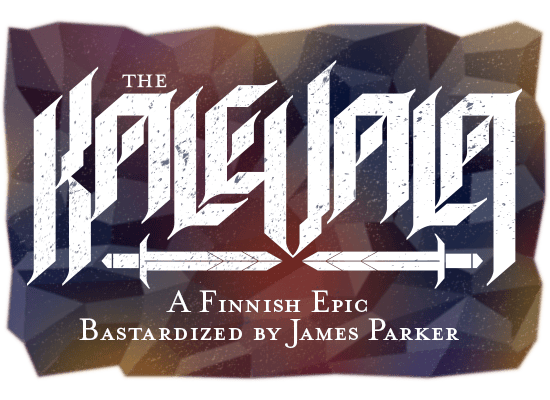THE KALEVALA (12)
By:
December 16, 2016
The Kalevala is a sequence of folkloric songs, runes and charms from the Karelia region of Finland, collected in the field and concatenated into epic form by Dr. Elias Lonnrot (1803-1884). The versions presented here are not translations or transliterations — they are respectful bastardizations, working from the 1963 English version of the Kalevala produced by the versatile and witty Francis Peabody Magoun Jr.

THE COWS COME HOME
[being a bastardization of The Kalevala, Rune 33, 118–284]
Depressed Kullervo sits and stares.
Misery stirs his nasal hairs.
His blade is flinders.
His mind is cinders.
The blacksmith’s bitch of a wife
baked a stone into a loaf of bread
and now his beloved knife is dead.
Plus — he’s hungry.
“Oh Kullervo,”
says the old crow in his scraped-up voice,
in his super-grackle crackle.
“This is a most grievous insult.
This is not to be borne.”
“Me?” says Kullervo at last.
“I shouldn’t have been born?”
“Well, that’s another subject,” says the
crow.
“We’ll come back to that, perhaps.
But for now, Kullervo, here’s what you do.
You grab yourself a nice stick,
a switch of young birch,
sap-springy, with a sting at the tip,
and you take all the cows,
your Bessie, your Tessie,
your Buttercup and your Blossom,
these heavy-headed dowagers
with their soft conversational noses,
and you drive them out into the wastes,
the wild wastes beyond the woods,
where every gentle thing gets ripped.”
“Ripped?” says Kullervo.
“Ripped!” says the crow.
“Drive these cows into the jaws of bears,
onto the muzzle-ends of writhing wolves.
Lip-lick, lip-curl, sneering at their fear,
Death peering through that grille of teeth
as through a visor,
Death spangling on the tip of a white
incisor.”
“That sounds AWESOME,” says Kullervo.
“Then you take the wolves and the bears
and you drive them home for the
blacksmith’s wife,
in a horror-herd, a mental dental mob.
That’ll give her something to think about.”
Kullervo chuckles.
“Who blows that horn?”
says the blacksmith’s wife at her threshold.
“I hear it pealing over the top of the hill.
But that boy doesn’t own a horn.
He doesn’t even own a pair of shoes.
And yet — how sweetly it blows.
Is my herd rumbling home now?”
The horn’s first note,
flashed off the hill’s edge,
is a sound from the stilly deeps of infancy,
the chilly weeps of infancy,
the stilly deeps, the chilly weeps, the frilly
sleeps of infancy.
The horn’s second note,
shivered out at twilight,
is a sound from the crack in the heart of
the world,
from the lack in the heart of the world,
from the crack, the lack, the never-get-it-
back in the heart of the world.
At the horn’s third note she covers her ears,
because it is loud, oh much too loud.
At the horn’s third note
her head fills with words
which curdle into curds
which turdle into turds
and her skull-walls drunkenly buzz
with the crude thick waves,
the reality-bending, earth-and-sky-
blending,
black wavy waves of the mind-killing horn,
payback for the insult not to be borne.
And Kullervo, revenge ninja,
flanked by the dripping mouths
of his wolves and bears,
is happy.
“Just die,” he says. “Be dead.
Their teeth are making a mess of you.
Bite by bite there’ll be less of you.
Finally just a scraggle of personality,
a spine-squiggle, and then you’re gone.
Good riddance!”
He will never be satisfied.
Series banner contributed by Rick Pinchera.
ALL INSTALLMENTS: INTRODUCTION: Laughter in the Womb of Time, or Why I Love the Kalevala | RUNE 1: “The Birth of Vainamoinen” | RUNE 2 (departure): “Vainamoinen in November” | RUNE 3 (1–278): “Wizard Battle” | RUNE 4 (1–56): “A Failed Seduction” | RUNE 4 (300–416): “Aino Ends It All” | RUNE 5 (45–139): “An Afternoon Upon the Water” | RUNE 5 (150–241): “The Blue Elk” | RUNE 5 (departure): “Smüt the Dog Praises His Seal Queen” | RUNE 6 (1–114): “Therapy Session” | RUNE 6 (115–130): “Joukahainen’s Mother Counsels Him Against Shooting the Wizard Vainamoinen” | RUNE 11 (1–138): “Introducing Kyllikki” | RUNE 17 (1–98): “The Dreaming Giant” | RUNE 23 (485–580): “The Bride’s Lament” | RUNE 30 (1–276): “Icebound” | RUNE 30 (120–188): “The Voyage of the Sea-Hare” (Part One) | RUNE 30 (185–188): “Losing It” | RUNE 30 (departure): “Across the Ice” | RUNE 30 (departure): “Song of the Guilty Viking” | RUNE 30 (departure): “The Witch’s Dance” | RUNE 31 (215–225): “The Babysitter” | RUNE 31 (223–300): “The Screaming Axe” | RUNE 33 (1–136): “The Cowherd” | RUNE 33 (73): “Song of the Blade: Kullervo” | RUNE 33 (reworked): “The Breaking of the Blade” | RUNE 33 (118–284): “The Cows Come Home” | RUNE 34 (1–82): “The Pipes of Kullervo” | RUNE 45 (259–312, departure): “The Wizard’s Secret”.
MORE PARKER at HILOBROW: COCKY THE FOX: a brilliant swearing-animal epic, serialized here at HILOBROW from 2010–2011, inc. a newsletter by Patrick Cates | THE KALEVALA — a Finnish epic, bastardized | THE BOURNE VARIATIONS: A series of poems about the Jason Bourne movies | ANGUSONICS: James and Tommy Valicenti parse Angus Young’s solos | MOULDIANA: James and Tommy Valicenti parse Bob Mould’s solos | BOLANOMICS: James traces Marc Bolan’s musical and philosophical development | WINDS OF MAGIC: A curated series reprinting James’s early- and mid-2000s writing for the Boston Globe and Boston Phoenix | CROM YOUR ENTHUSIASM: J.R.R. Tolkien’s THE HOBBIT | EVEN MORE PARKER, including doggerel; HiLo Hero items on Sid Vicious, Dez Cadena, Mervyn Peake, others; and more.
